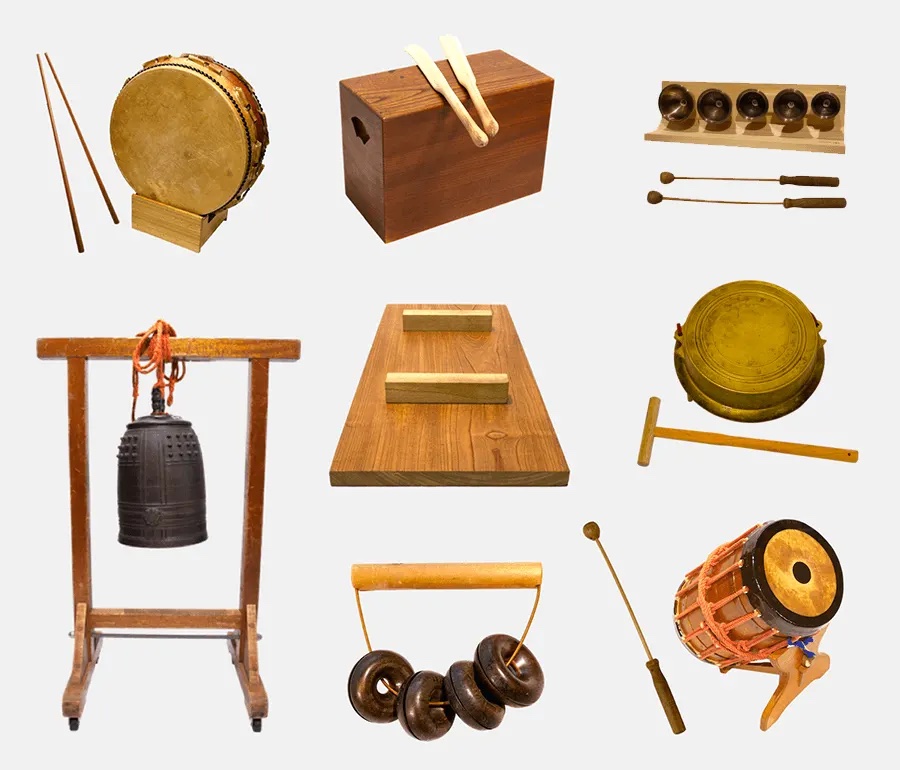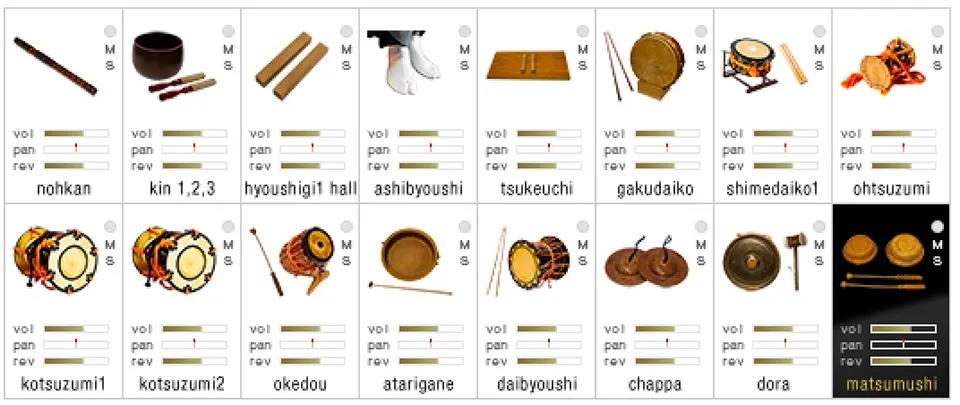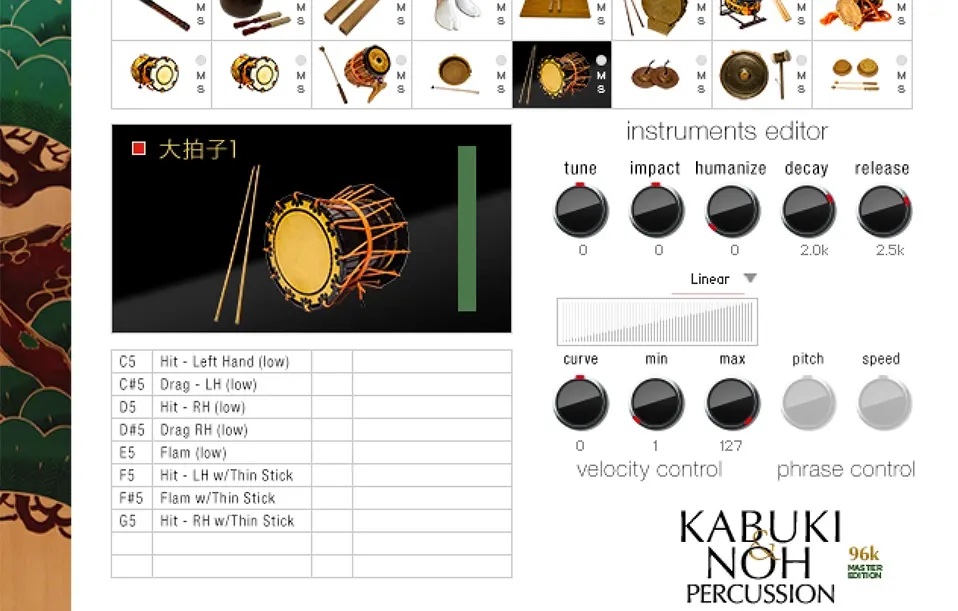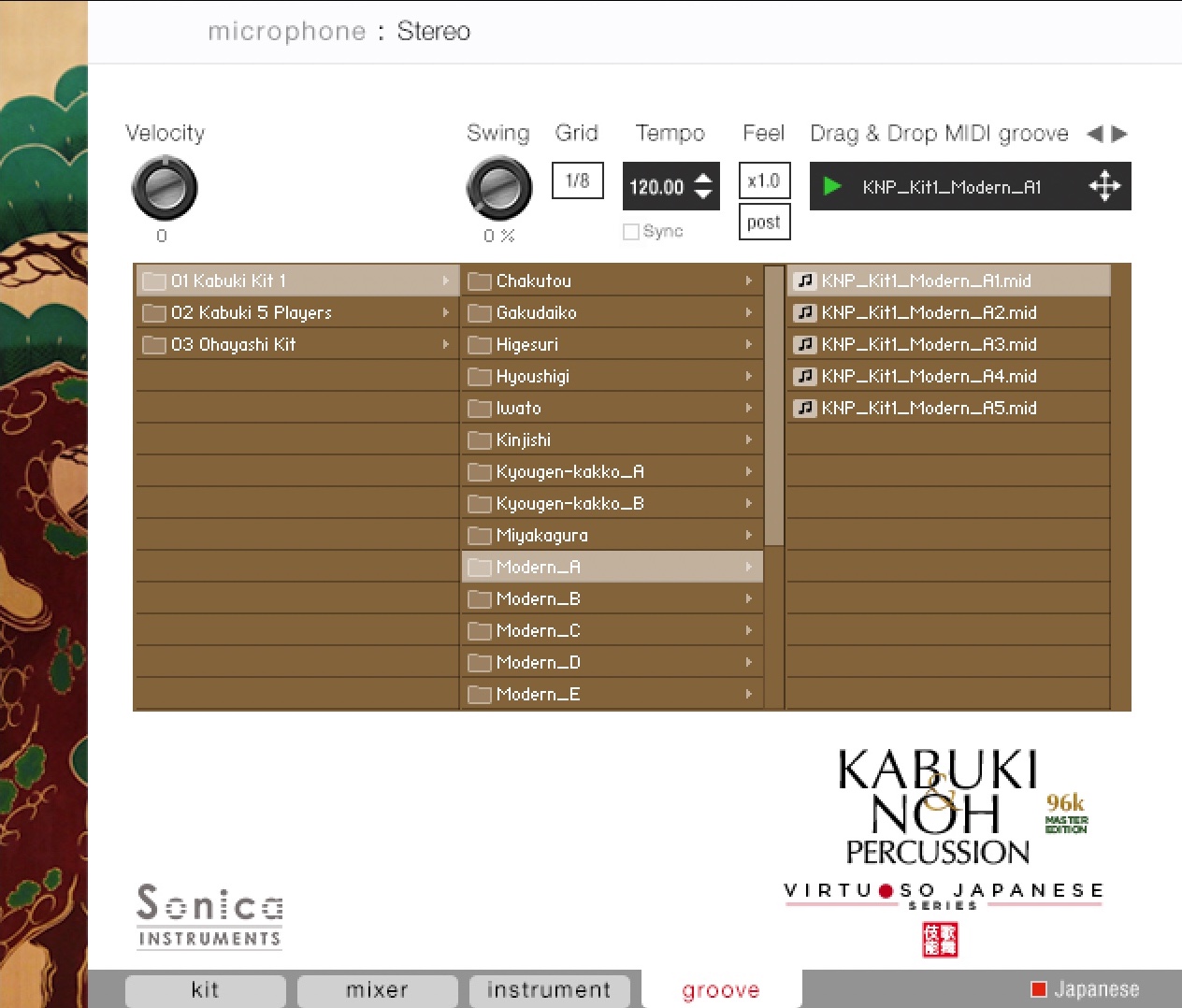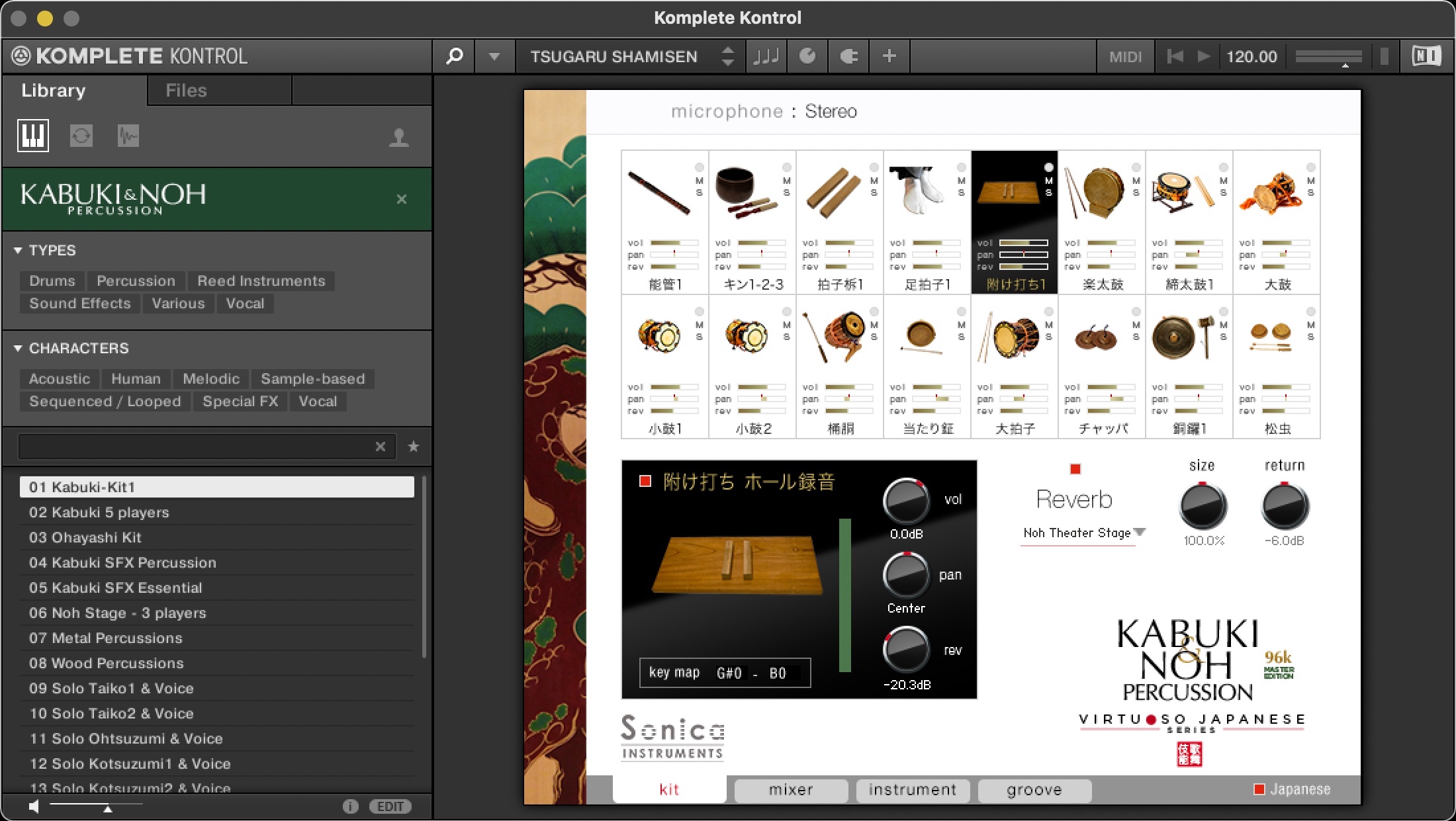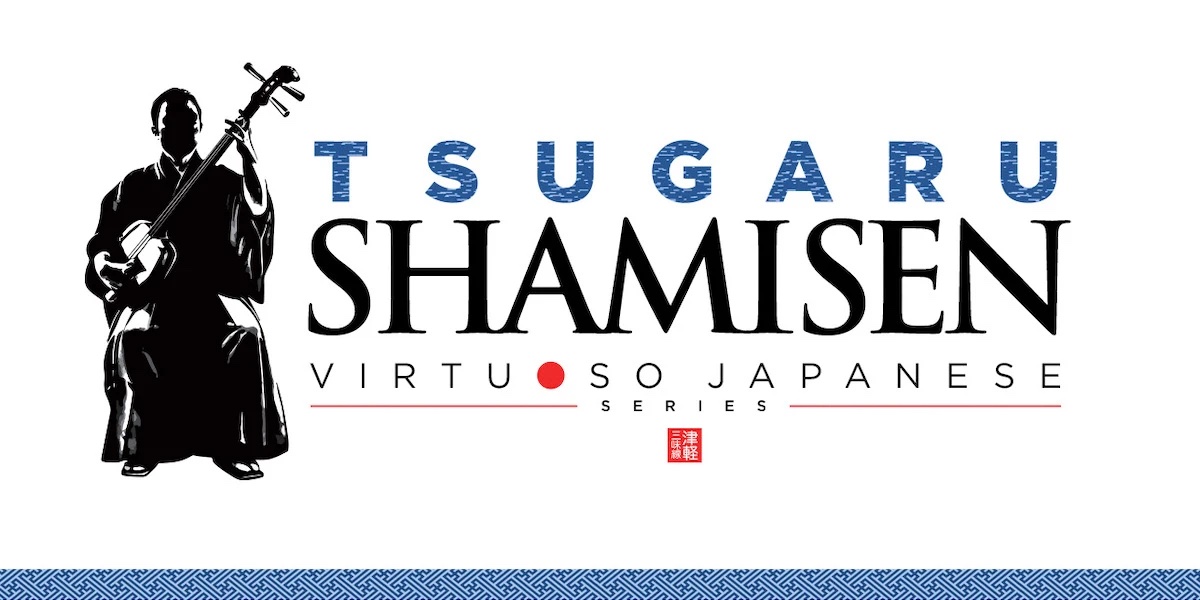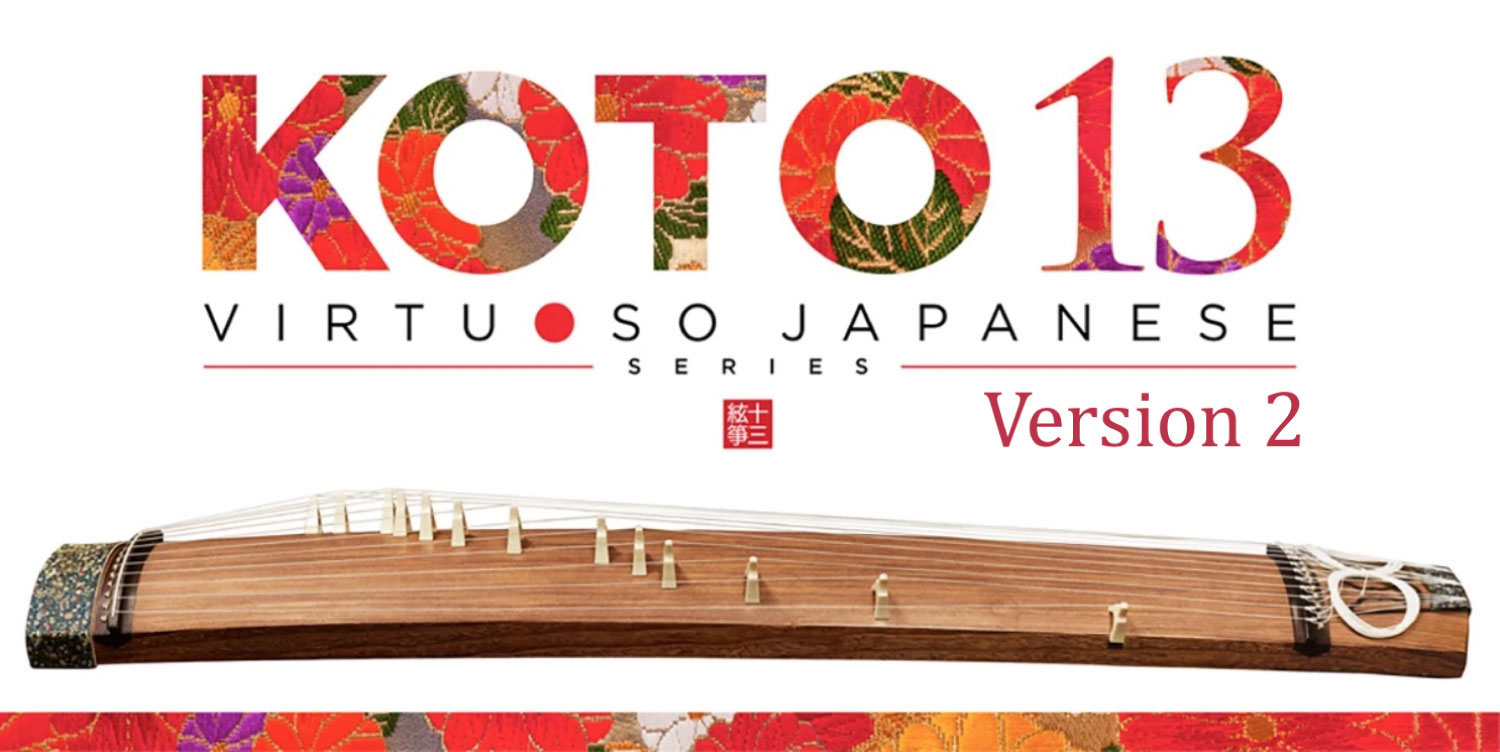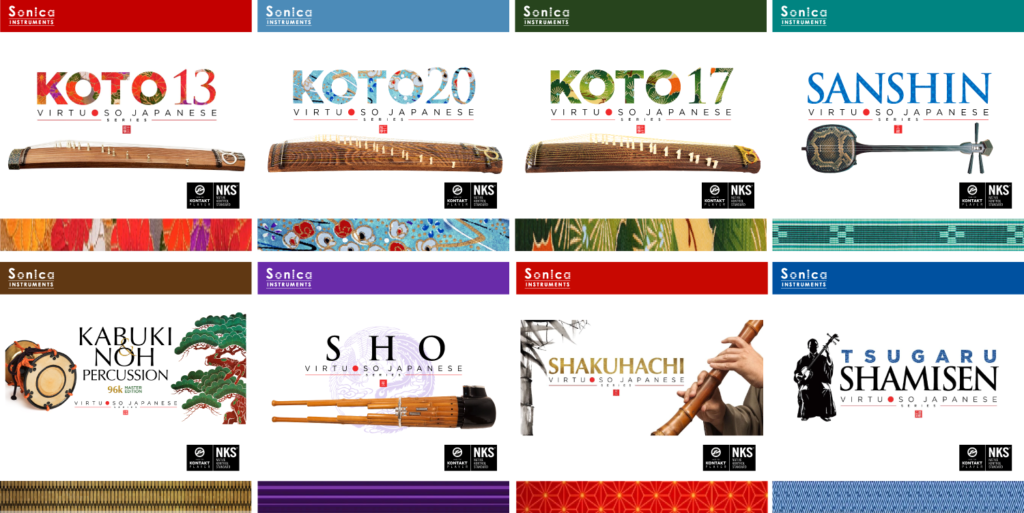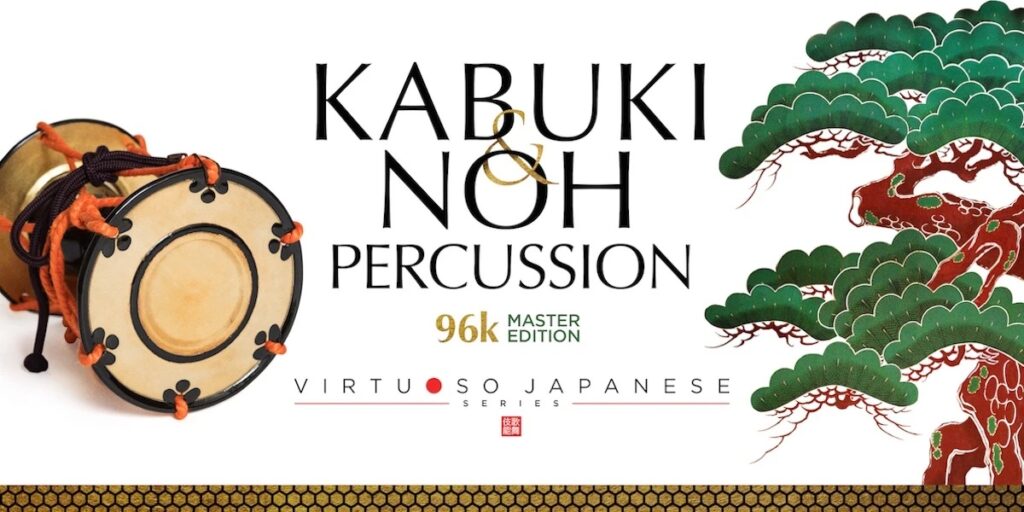
Seven years have passed since we released the incredibly popular KABUKI & NOH PERCUSSION library.
Over this time, we have gradually upgraded and expanded our large collection of recordings and samples of percussion instruments featured in Kabuki and Noh theater.
We are now finally releasing this work as a massive upgrade entitled KABUKI & NOH PERCUSSION 96k MASTER EDITION — a Kontakt library with full-on professional specs and Sonica Instrument’s unparalleled quality.
KABUKI & NOH PERCUSSION 96k MASTER EDITION puts the sounds of Japan in the hands of all music creators.
Main Features
- Contains 65 types of percussion instruments — virtually every percussion instrument known in Kabuki and Noh theater — in 96 kHz / 24-bit high resolution.
- Each instrument has been recorded in a rich multi-mic setting, with Direct 1, Direct 2, Overhead, Room, and Stereo Mix channels available (the sample data is equivalent to about 40 GB in WAV format or about 20 GB in NCW format).
- Features two newly-recorded bonus libraries: a library of hayashi ensemble kakegoe calls and a library of Nohkan flute phrases.
- Individually recorded left-hand and right-hand hits are sampled alternately with up to 100 velocity layers to create extremely realistic dynamics and roll expressions.
- 20 preset kits, each with a carefully selected assortment of instruments loaded in 16 instrument slots.
- 144 authentic hayashi percussion grooves (MIDI patterns).
- The built-in Instrument Editor gives full control over tuning and tone without any loss in sound quality or instrument timbre.
- The Instrument Mixer lets you create your own fine mixes for individual instruments.
- Includes impulse responses from a Noh theater renowned among Noh musicians for its acoustics.
- NKS ready and Kontakt Player compatible.
$330
$330 $215
Special sale price available until August 15, 2025.

Product Specifications
- Kontakt Player 6.6 and higher.
- Native Access compatible
- Data size:19 GB
User manual
96 kHz / 24-bit high-fidelity samples Rich, high-resolution samples
of virtually every percussion instrument known to Kabuki and Noh theater
The original KABUKI & NOH PERCUSSION (BFD format) software library covered many Kabuki and Noh theater percussion instruments. Over the seven years since its release, we have made fresh, powerful recordings with even higher sound quality of the Nohkan flute, kakegoe calls, and ashibyoushi foot stomps on a Noh stage.
KABUKI & NOH PERCUSSION 96k MASTER EDITION contains over 60 instruments with uncompromising specs — 96 kHz / 24-bit high resolution with multiple mic channels — for an even larger audience of music creators.
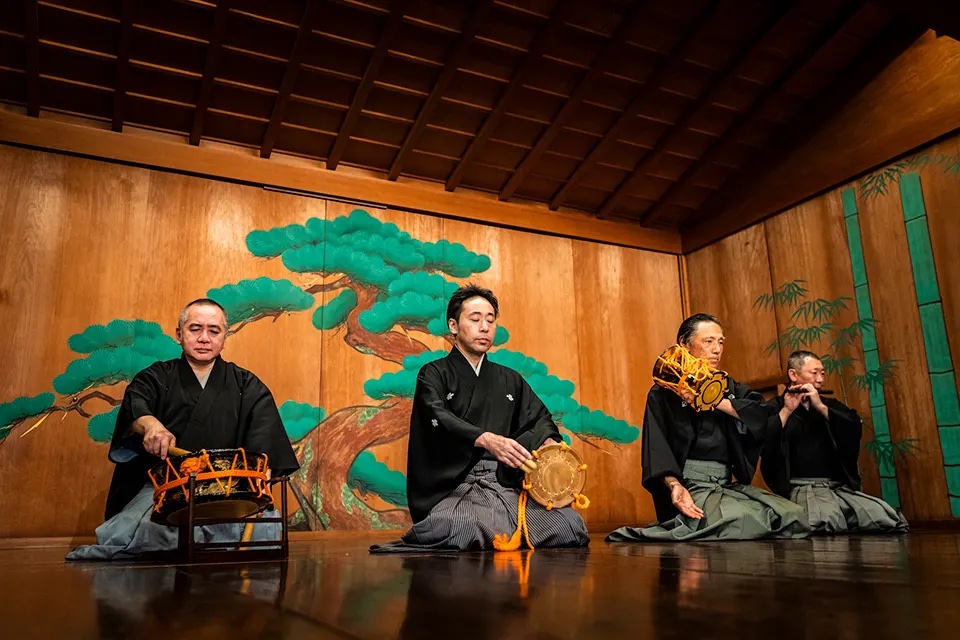
Vivid natural dynamics and the inherent expressive force of Japanese instruments
Separately recorded left-hand and right-hand hits are sampled alternately with up to 100 velocity layers for very natural-sounding dynamics and roll expressions.
The kotsuzumi is best known for its distinctive pon sound, but the instrument in fact harbors a rich palette of expressions. In addition to providing the crisp pon, pu, chi, ta, and pe percussive taps, the library lets you use a velocity controller for full control over nuanced portamento slides that are created by squeezing and releasing the drum’s cords.
Taking the shimedaiko for example, we captured left-hand and right-hand hits separately. But we also included all key articulations native to the shimedaiko, such as the tsuke effect, where bachi sticks strike and then rest on the drum head.
A wealth of rare instruments
The collection contains many rare instruments, such as the ekiro (a doughnut-shaped horse bell), orgol (a music box), matsumushi (a small flat gong), fusegane (an altar gong), hontsurigane (a large bell), and other Kabuki sound effects.
The odaiko can express the wind, snow, water, and other natural elements as well as the inner thoughts and feelings of actors on stage. It can even imitate the spookiness of a ghost’s entrance. The Master Edition features odaiko articulations played with nagabachi (long, tapered sticks for sound effects) and yukibai (a special stick to imitate the sound of snow), giving music producers the scope to recreate every nuance of the odaiko in Kabuki.
20 preset kits, each with a carefully selected assortment of instruments loaded in 16 slots
KABUKI & NOH PERCUSSION 96k MASTER EDITION has 16 instrument slots. The preset kits let you quickly load instruments in the slots for specific musical contexts. For example, you can load a kit with instruments specifically for the Kabuki stage, a kit with instruments specifically for the Noh stage, or a kit with Kabuki sound effects.
Naturally, you can edit any preset kit and arrange instruments to your liking.
Two newly-recorded bonus libraries of kakegoe calls and Nohkan flute phrases
We extended the library’s content to be the definitive library of hayashi ensemble sounds.
Voices of Kabuki & Noh contains a wide collection of real hayashi kakegoe calls, while Nohkan Flute is packed with quintessential Nohkan phrases.
All samples in both libraries have been newly recorded for this release, so you can build the most complete hayashi ensemble possible.
VOICE of KABUKI & NOH
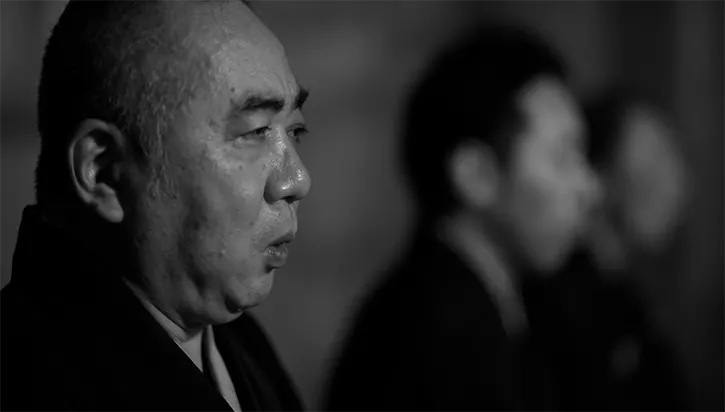
A library of kakegoe calls essential to any Kabuki or Noh hayashi performance
The library contains “ya” calls, such as iyoh and yohi, and “ha” calls, like hou and ha, each performed by two taiko performers, two ohtsuzumi performers, and two kotsuzumi performers, for a total of six versions of each call. The collection is topped off by gorgeous unison calls by all the musicians for the most complete compilation of kakegoe performances ever.
NOHKAN FLUTE PHRASES
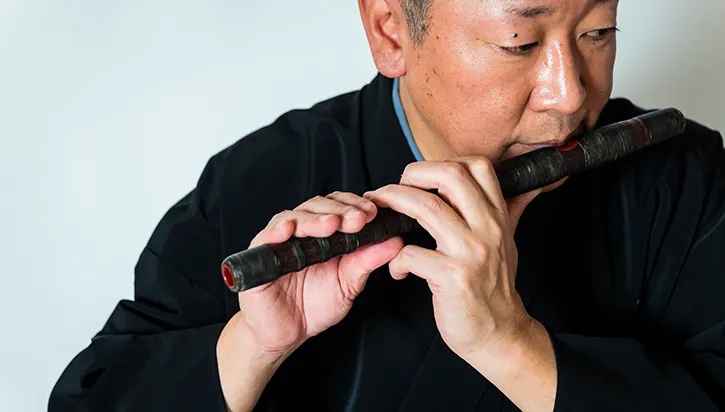
A virtual encyclopedia of Nohkan flute phrases
This library features well-known hishigi, netori, ashirai, and nanori phrases as well as numerous passages from such musical works as ranjo, chunomai, kyogen kakko, maiji, gaku, abare, iwato, sarashi, hayafue, and kakeri.
Instrument Editor gives full control over tuning and tone of each instrument
The Instrument Editor’s controls let you precisely adjust the tone of each instrument without affecting the sonic quality of the percussive attack transients. For example, you can re-pitch the instrument or adjust the strength of the attack transient. This gives you the ability to endlessly modify instrument colors to your liking, with no loss in the rich high-resolution sound quality.
Individual instrument mixers
The Instrument Mixer provides fine adjustments of the five microphone channels — Direct 1, Direct 2, Overhead, Room, and Stereo Mix —for each instrument. The mixer gives you full freedom over the mix balance to suit any situation. You can also insert compression and EQ on the instrument’s master mix bus.
The library contains impulse responses from a Noh theater renowned among Noh musicians for its acoustics. The impulse responses are used with the built-in convolution reverb function. There are two responses: one from the stage and one from the audience seats.
MIDI Groove Browser
KABUKI & NOH PERCUSSION 96k MASTER EDITION features the incredibly useful Groove Browser, that lets you quickly find MIDI grooves and drag & drop grooves directly into your DAW.
You can adjust the grooves’ velocity, swing, playback tempo, and other parameters directly from KONTAKT / KOMPLETE KONTROL.
The library comes packed with exclusive hayashi ensemble grooves (MIDI patterns) often heard in Kabuki.
When combined with the soon-to-be-released Groove Inspirations MIDI pack, the Groove Browser gives you access to an extensive phrase bank.
NKS & Native Access ready
KABUKI & NOH PERCUSSION 96k MASTER EDITION is NKS compatible so it can be used with Kontakt Player, Kontakt Full (Ver. 6.6 or newer), and Komplete Kontrol.
When KABUKI & NOH PERCUSSION 96k MASTER EDITION is linked with a Komplete Kontrol keyboard or other NKS-compatible hardware, you can quickly preview tones and make full use of the hardware’s knobs and controllers.
Recorded instruments
- Taiko drum series -
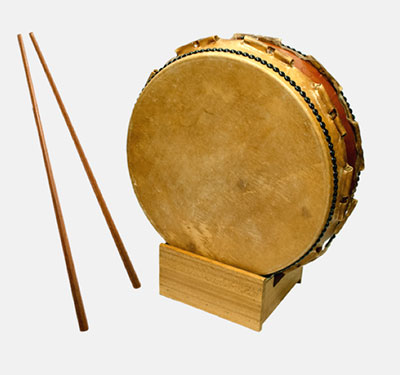
Odaiko (Gakudaiko) - Nagabachi
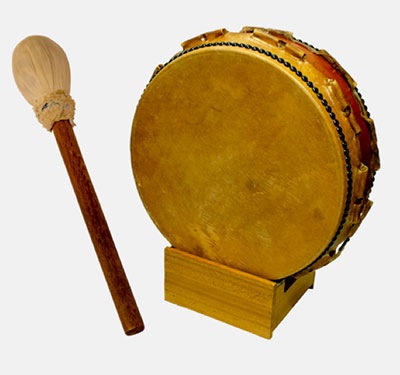
Odaiko (Gakudaiko) - Yukibai
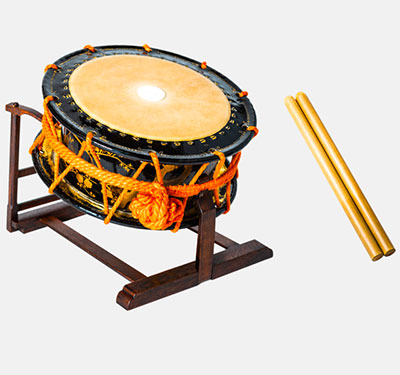
Shimedaiko - Futobachi
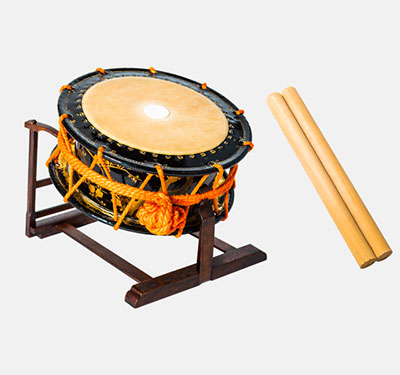
Shimedaiko - Hosobachi
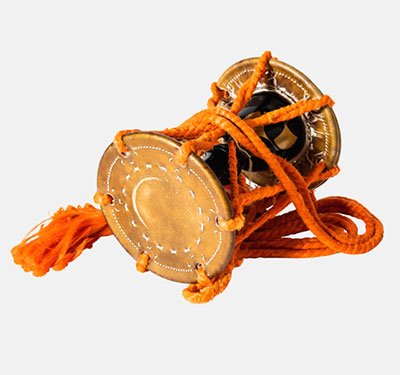
Ohtsuzumi 1
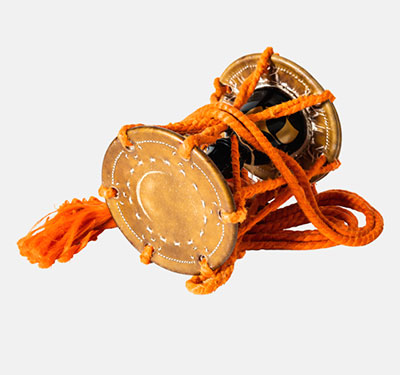
Ohtsuzumi 2
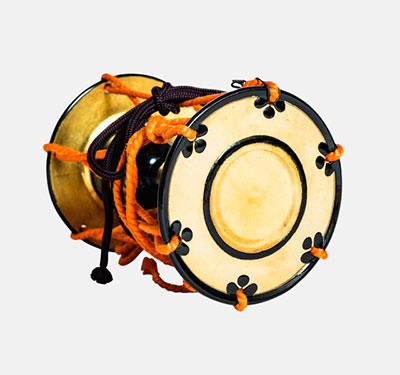
Kotsuzumi 1
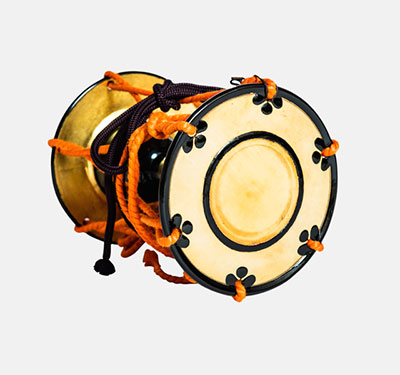
Kotsuzumi 2
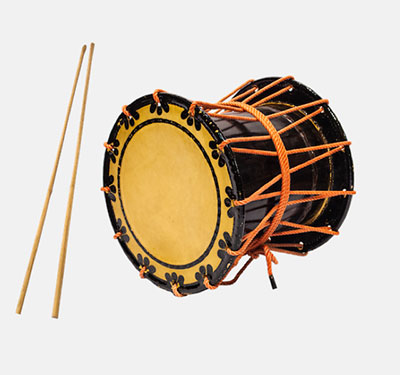
Daibyoushi - Bamboo stick
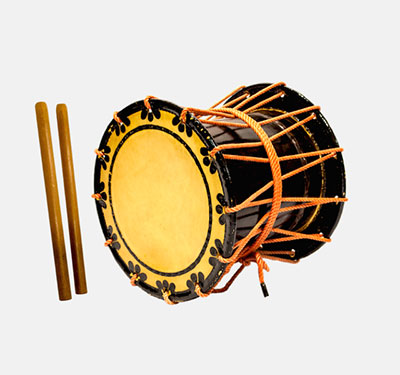
Daibyoushi (low tuning) - Hosobachi
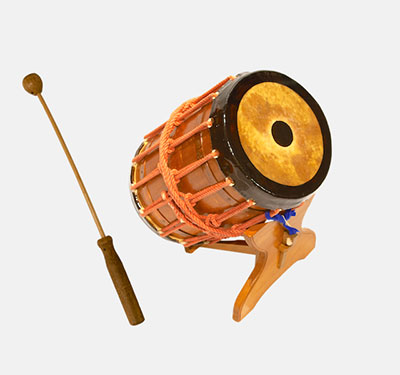
Okedou
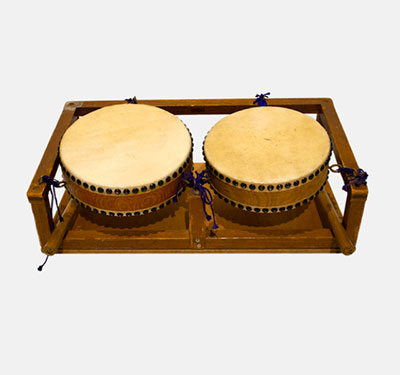
Mamedaiko - Large and small pair

Uchiwadaiko - Extra large
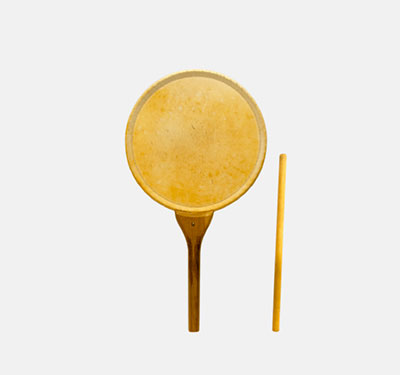
Uchiwadaiko - Large
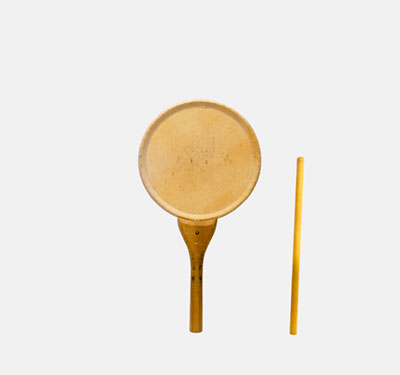
Uchiwadaiko - Medium
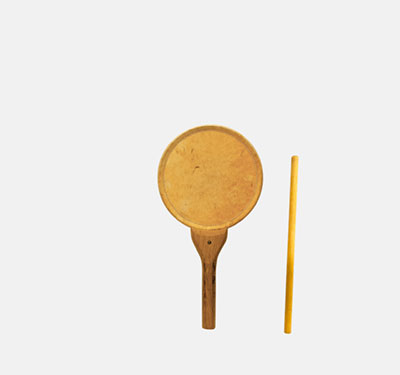
Uchiwadaiko - Small
- Bells, gongs, and cymbals -
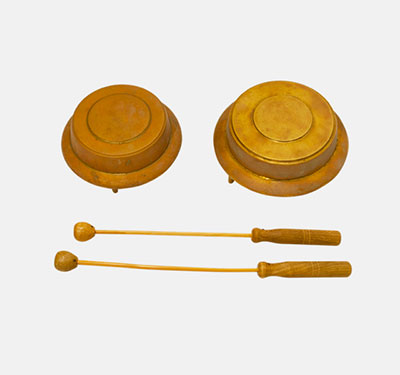
Matsumushi - Low pitch, Matsumushi - High pitch
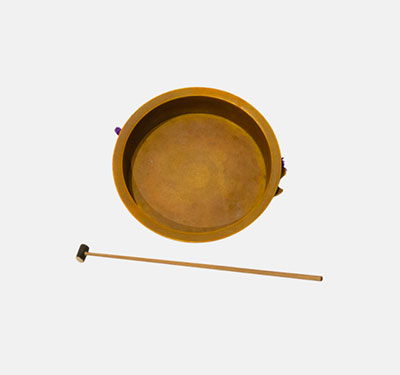
Atarigane - Held
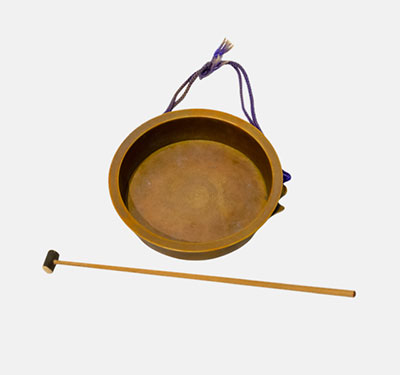
Atarigane - Hanging

Konchiki
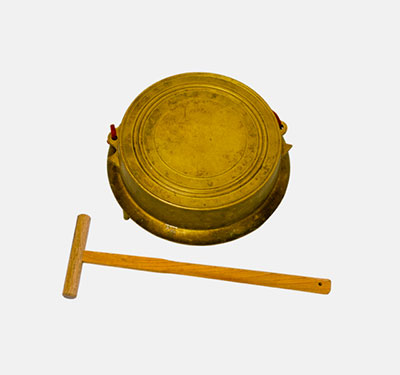
Fusegane
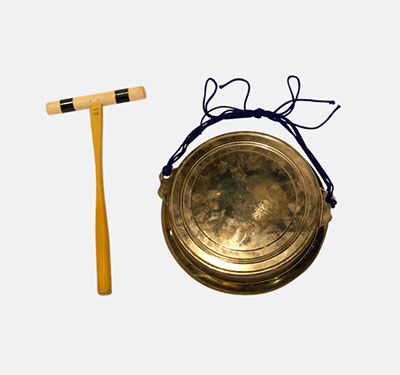
Souban
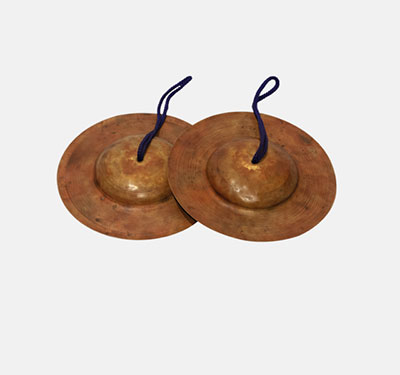
Chappa
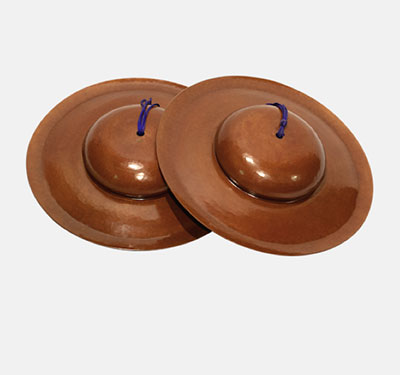
Myouhachi
- Metallic percussion instruments -
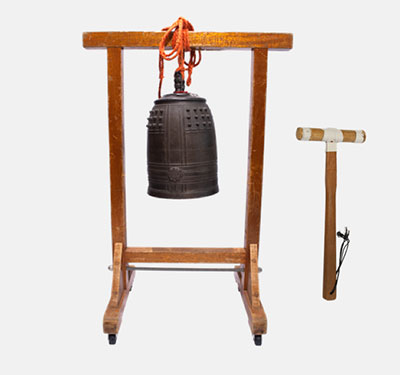
Hontsurigane - Shumoku
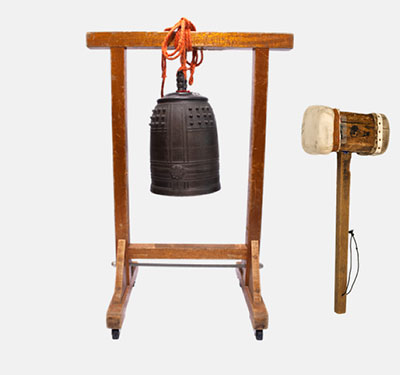
Hontsurigane - Kizuchi
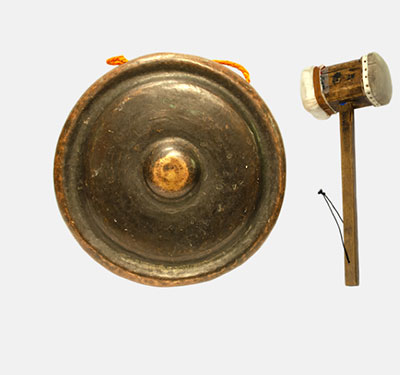
Dora 1 - Large
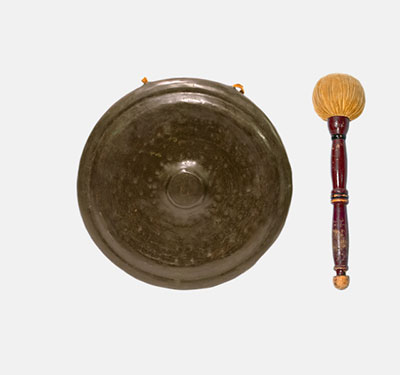
Dora 2 - Small
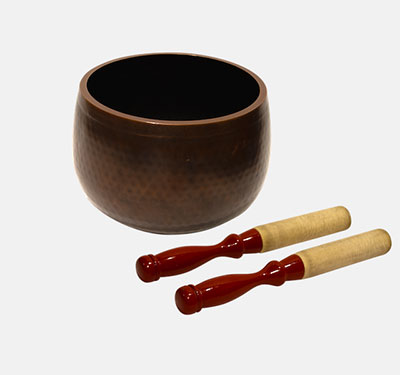
Kin 1 - Large
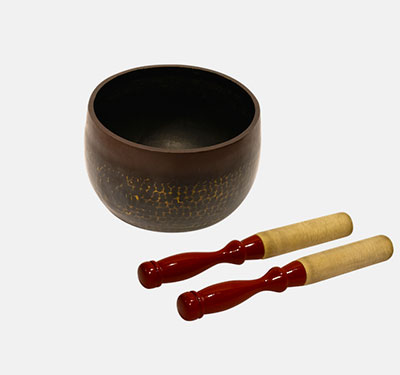
Kin 2 - Medium
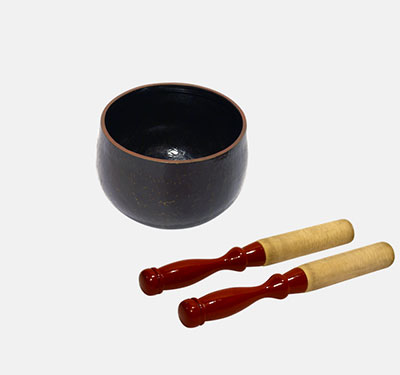
Kin 3 - Small

Ekiro
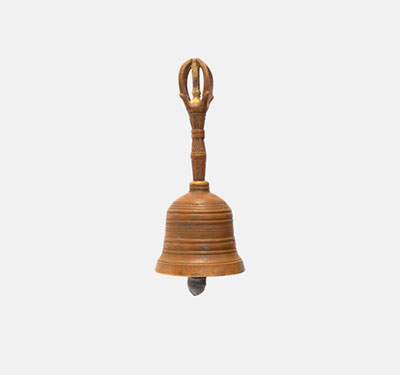
Rei
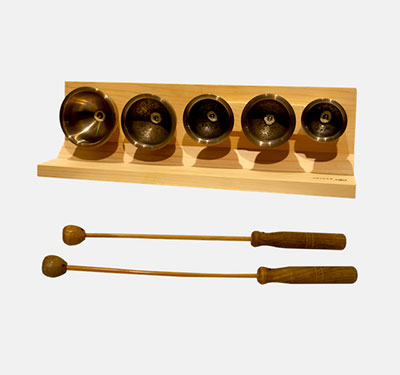
Orgol
- Wooden percussion instruments -
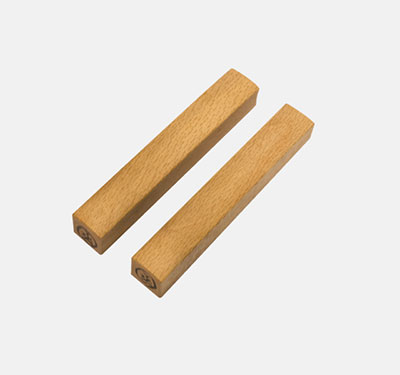
Hyoushigi 1 - Hall recording
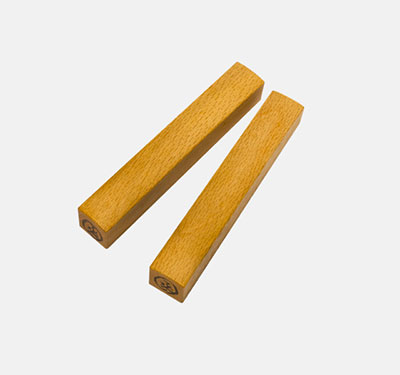
Hyoushigi 2 - Studio recording

Kinuta
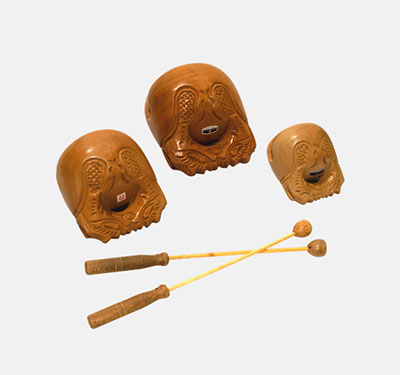
Mokugyo - Large, medium, and small
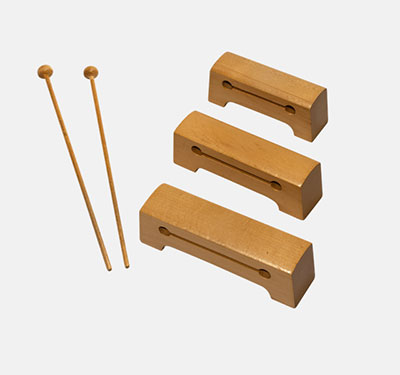
Mokushou - Large, medium, and small

Harisen
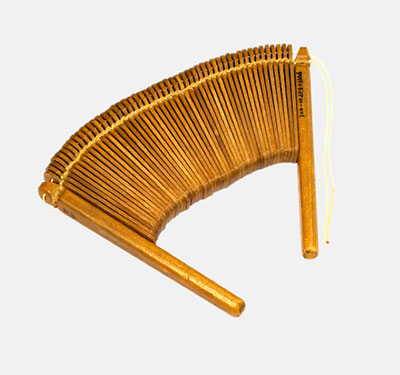
Binzasara 1

Binzasara 2 - Kokirikobushi
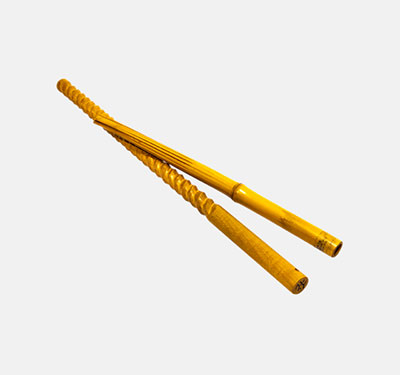
Bouzasara

Takenaruko
- Stage sound effects -
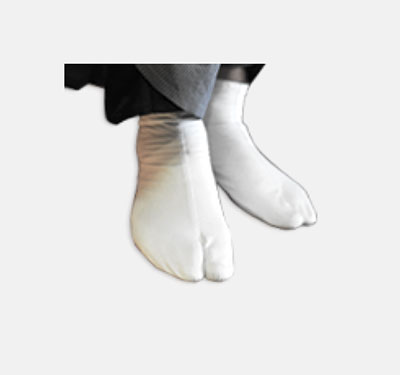
Ashibyoushi - Kabuki
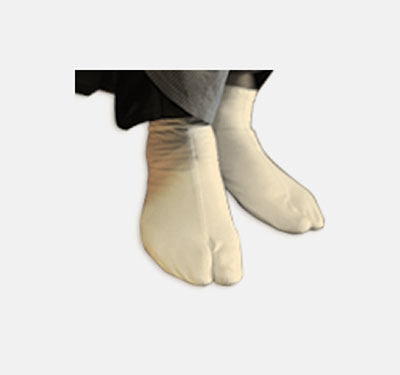
Ashibyoushi - Noh
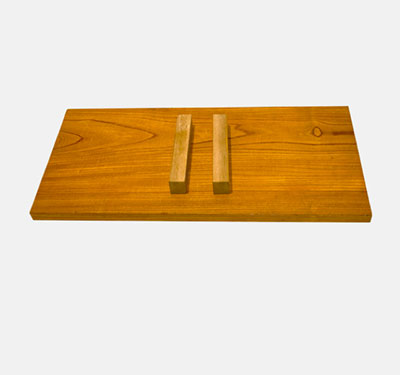
Tsukeuchi 1 - Hall recording
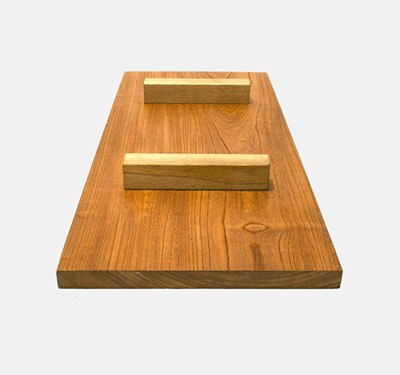
Tsukeuchi 2 - Studio recording
- Kakegoe calls -

Kakegoe Taiko 1
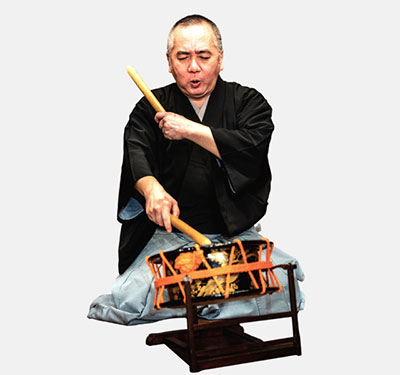
Kakegoe Taiko 2
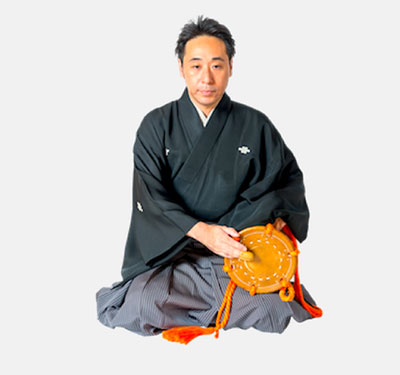
Kakegoe Ohtsuzumi 1
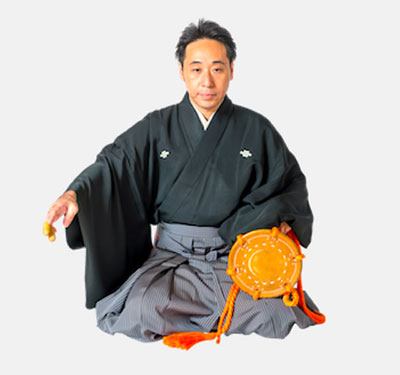
Kakegoe Ohtsuzumi 2
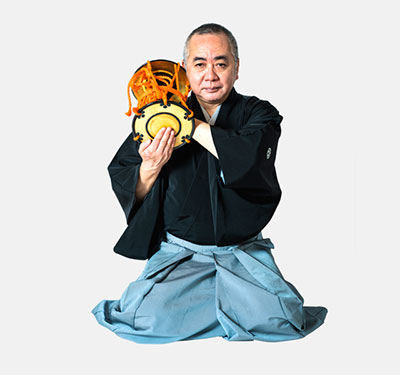
Kakegoe Kotsuzumi 1
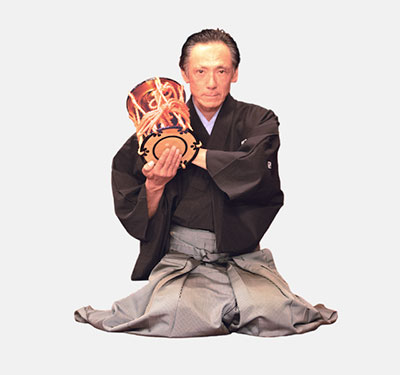
Kakegoe Kotsuzumi 2

Kakegoe Trio A

Kakegoe Trio
- Nohkan flute phrases -

Nohkan 1
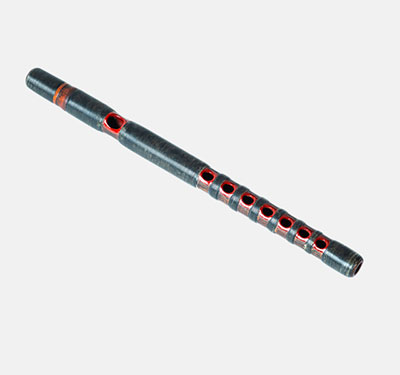
Nohkan 2
Product Specifications
| Format | Free KONTAKT PLAYER version 6.6 and higher, or KONTAKT version 6.6 and higher. |
| Data size | ~19 GB NCW format (equivalent to 40 GB in wav format) |
| System Requirements | See the Native Instruments website for the latest system requirements for KONTAKT and KONTAKT PLAYER. |
| User manual | Online Manual |
Related Products
KOTO 13 Version 2
A Kontakt library reproducing the nuances of the 13-string koto so naturally it feels like your fingers are touching the strings


